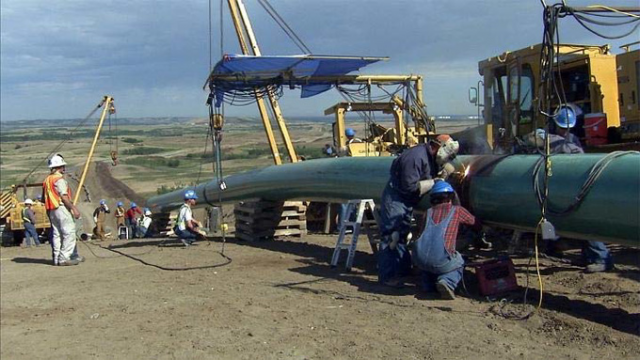Have Oil By Rail Shipments Peaked In North Dakota?

The safety of oil-by-rail shipments of Bakken crude is an issue making national headlines of late, notably because of explosive derailments in Ontario (where 47 people died) and Casselton, North Dakota (where, thankfully, nobody was even injured). The industry says the oil is fine, and that what we have is a railroad problem. Others say Bakken crude is too volatile and needs to be stabilized before shipment by rail.
But as that debate goes forward, it seems as though North Dakota is set to see a major shift to pipelines for shipping oil. I wrote about it at Watchdog.org today:
According to numbers prepared by the North Dakota Pipeline Authority and presented to the Legislature’s interim Energy Development and Transmission Committee, 63 percent of the oil produced in the state in April was shipped by rail. That’s down from a peak of 75 percent in April 2013.
You can read the full presentation from the North Dakota Pipeline Authority to the interim committee here.
This chart from the report shows the trendlines for where oil production goes (on rails, in pipelines, etc.). As you can see, rail as a percentage seems to have peaked:

Pipelines, though, haven’t really taken off yet as a percentage of shipped oil, but that’s changing. There is a lot of new pipeline capacity coming online this year, and by 2016 capacity will have doubled:
In June, Gov. Jack Dalrymple, a Republican, announced the state’s oil pipeline capacity would exceed 783,000 barrels per day by the end of 2014, a 173 percent increase over the state’s 286,000 barrels per day capacity in 2009.
It appears as though that goal will be a reality.
Two major pipeline projects — the Butte Loop and the Hiland Double H — capable of taking a combined 160,000 barrels per day of oil to Guernsey, Wyo., are scheduled to be in service later this year. In May, the Plains Bakken North pipeline went online, taking 40,000 barrels per day to Canada.
In April, the state produced just more than 1 million barrels of oil per day, according to the Industrial Commission’s Department of Mineral Resources. With production still growing, Dalrymple has predicted that the state’s pipeline capacity will hit “about 1.4 million barrels per day” by the end of 2016.
That prediction, too, seems set to come true.
The Sandpiper, Enterprise and Energy Transfer Partners pipelines — taking oil to Superior, Wisconsin, Cushing, Oklahoma and Potoka, Ill., respectively — are scheduled to be in-service in 2016, representing another 795,000 barrels per day of capacity.
Of course, the state’s oil production numbers keep increasing too, so even as pipeline capacity grows to exceed current levels of per-day production, total production is going to continue growing as well. So rail is still going to be used.
Still, we’re going to see a big shift to pipelines, and that’s a good thing for the safe transport of oil.




